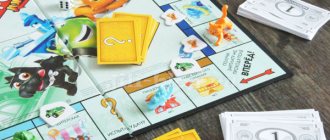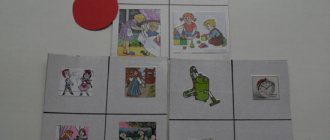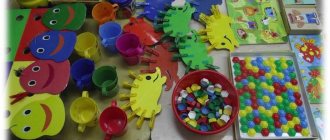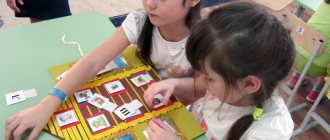Recommendations from psychologists and teachers
Psychologists recommend studying the characteristics of preschool children, 5-6 years old in particular. You need to understand that during this period students are already able to reason and apply their knowledge to benefit. The analysis gradually goes beyond the scope of visual experience, and the child expands his horizons. Accordingly, you need to communicate with children positively, but not “babble”. Also, do not stop children who want to show their imagination.
At this age, the child is already able to come up with a story with a certain sequence and outcome. However, the teacher should not forget about his role and hierarchy. The group must understand that this is not just an uncontrolled game, but an exercise conducted by an adult, that is, a teacher. Teachers recommend learning new techniques and exercises.
It must be taken into account that modern children are more progressive; even at 5-6 years old, many of them are perfectly able to use tablets, computers and many other devices. This means that sometimes it is worth placing more emphasis on the development of visual activity and fine motor skills.
Methods of working with children must be constantly improved in order to help children develop correctly and prepare to enter a new phase - going to school.
Accordingly, the child must gradually learn discipline. Of course, a lot of work must be done by parents as well. Games and other materials can be provided to parents of students so that they can reinforce the results at home.
Accordingly, didactic games on ecology, which are held in the senior group of kindergarten, are of great benefit and contribute to the diversified development of students. There is a wide variety of different ideas. Games with a ball and bright cards demonstrate the greatest effectiveness.
Class index
Creating and colorfully designing cards is necessary for fruitful work with students in the senior group of kindergarten. The card index itself is the cards that will be used during the games. They should be comfortable and large. It is advisable to laminate them.
This is an auxiliary material that allows not only to better hold children’s attention, but also greatly facilitates the exercise and makes it more interesting. Cards are great not only for group lessons, but also for individual lessons.
How to interest a child
Didactic games on ecology in the senior group should be conducted by a specialist. The teacher’s task is to interest the student in the process of classes at the preschool educational institution. The child should be maximally involved in didactic and other games, during which he will gain the necessary knowledge and skills. Beginning teachers are faced with the problem of how to attract and hold the child’s attention during the lesson.
There are several aspects that will help solve this problem:
- At this age, the child is not very susceptible to intonation and timbre changes in the teacher’s voice. He shows much greater interest if he sees so-called bright colors or expects a surprise.
- During classes, the teacher should not monotonously follow the plan. It can diversify the lessons by adding some entertainment elements such as an interactive whiteboard, multimedia projector, tablet and much more.
- You can start classes with some mysterious subject, telling the child that the teacher has something interesting that the children will really like. In anticipation of what is expected, children will complete tasks with interest.
- The teacher must understand that the child’s attention is involuntary. Accordingly, the learning process should take place in a playful form. That is, children should see that the teacher is enjoying the game process.
Didactic games on ecology in the senior group require the participation of the teacher. He presents the material in a playful manner and enjoys the progress of the game. - The more interactivity a game has, the more interest it will arouse in a child, as it allows him to gain real life experience. At this age, children love to touch objects, taste and smell them. You can use various soft toys, images and much more.
- If cards with images are used in the gameplay, then it is desirable that they be bright colors, colorful with visual effects. A child at this age likes bright balloons, ice cream and many other things that stand out against the background of common objects.
- Musical accompaniment will also help to interest the child. When conducting didactic games, it is not necessary to force children to sit in one place. If you choose the appropriate music, the exercises will immediately become much more interesting.
- It is recommended to change activities in a timely manner. You shouldn’t keep children’s attention on one game for too long; it’s better to change direction. The more cards and different tasks alternate, the easier it will be to maintain attention. It is worth considering that for a child aged 3-4 years, the limit of involuntary attention is no more than 4 minutes. At 7 years old, this figure can reach up to 12 minutes. Therefore, you should not perform one exercise for more than 5-10 minutes.
Features of children's development
Children at the age of 6 are already able to correctly distribute roles even before the start of the game and structure their behavior, adhering to a given role. During play interaction, the child must speak words and make decisions that, in their content, will correspond to the chosen topic. At this age, the child begins to gradually master and apply various social models of interaction.
For example, he understands that next to an adult he must take a subordinate position when it comes to a kindergarten teacher. When distributing the roles of didactic games, minor conflicts may arise, since there are roles that will be most attractive to children. In turn, other gameplay may seem less entertaining.
Didactic games on ecology in the senior group are an effective method of conveying information and forming the correct perception. But we must also remember that at this age the child’s visual activity begins to actively develop, and the period of drawing begins. In just 1 year, a preschooler can create up to several thousand drawings of various themes and content. This is the clearest description of a child's impressions of everyday situations.
During this period, the child creates imaginary situations or illustrates what he has seen in films or books. From 5-6 years old, a child is able to create only schematic images of various objects. Simple drawings can be distinguished by original solutions and correct composition. Such illustrations allow us to assess the development of the child and the dynamics of his relationships with the outside world.
If you look at repeated plots in your work, you can identify possible problems.
Also at this age the construction stage begins. The child learns methods of analyzing the conditions and situations in which his activities are carried out. During this period, various parts of the designer, auxiliary elements and much more may be involved. As a result, the child learns to create more complex buildings.
Also at this stage, the child examines samples and can create some designs not only according to a clear diagram, but also depending on his own vision. Another feature is that at this age the process of perceiving the color form and size of objects begins to improve. That is, the child can already name not only the color, but also its various shades, more complex geometric shapes and begins to evaluate their size.
He can easily construct objects of the same shape, but of different sizes, in descending or ascending order. At this age, some children encounter difficulties in the process of analyzing the spatial state of things. This is due to the fact that in order to assess the placement of an object, it is necessary to take into account several signs at once, which may even be opposite.
School-age children cope well with this task, but preschoolers may find such exercises difficult. In older preschool age, there is an active development of imaginative thinking. This means that the child can not only correctly solve a problem following a visual plan, but also transform the specified object or interact with it in another way.
Additionally, at the age of 5-6 years, generalization methods are improved and verbal and logical thinking expands. The child is still poorly oriented in the classes of objects, but is able to group them according to simple, more general characteristics.








